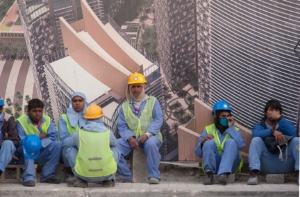4 Facts about Hunger in Qatar
 The State of Qatar is a small country located on the Qatar Peninsula in the Middle East, neighboring Saudi Arabia on its southern land border and surrounded by the Persian Gulf on all other sides. Since gaining its independence from Britain in 1971, Qatar has been a constitutional monarchy. It is a desert nation with a small population of 2.6 million, 99.4% urban, with only 1.1% of its land arable. Its economy is driven largely by its natural gas and oil reserves.
The State of Qatar is a small country located on the Qatar Peninsula in the Middle East, neighboring Saudi Arabia on its southern land border and surrounded by the Persian Gulf on all other sides. Since gaining its independence from Britain in 1971, Qatar has been a constitutional monarchy. It is a desert nation with a small population of 2.6 million, 99.4% urban, with only 1.1% of its land arable. Its economy is driven largely by its natural gas and oil reserves.
Despite its strong economy and high per capita income, Qatar still faces issues related to hunger. Here are four facts about hunger in Qatar.
Qatar’s Global Rankings
In 2024, Qatar ranked 30th out of 113 countries in the Global Food Security Index (down from 13th in 2019)—an international database that considers quality, affordability and availability of food. However, while Qatar is ranked 9th in availability and 21st in affordability, it is only 47th in quality and safety and 51st on sustainability and adaptation. Some of its weakest indicators are lack of a national policy or strategy to empower women farmers, extent of agricultural research and development and extent of disaster risk management. Qatar could not be comparatively ranked on the 2024 Global Hunger Index because of a lack of available data on undernourishment. But on the other GHI indicators related to hunger, the country’s statistics are very low: 6.2% of children under 5 stunted and 1.5% wasted, and 0.5% of children who die before their fifth birthday.
Dependency on Imported Food
Agriculture is a challenge in Qatar because of the arid climate, sandy soil and scarcity of water. Qatar therefore has imported 90% of consumed food, with imports providing as high as approximately 80% of the demand for perishable crops.
Qatar’s Large Migrant Worker Population
Qatar is home to a million person, mostly Asian, migrant work force, which is 95% of its total labor force, with half of these workers in construction. The high COVID toll in Qatar five years ago left many migrants jobless, and hungry. Subsequently, the FIFAWorld Cup 2022, hosted by Qatar, exposed “the vulnerabilities of and abuses faced by low-paid migrant workers and migrants in general.” During this same period, the Canadian-based Migration and Food Insecurity in Cities of the Global South project (MiFood Project) expanded its Hungry Cities Partnership research network to additional countries, including Qatar. This was a three-year project focused on migrant workers and food security.
Success and a New Strategy to Increase Food Security
Qatar’s successful National Security Strategy 2018-2023 strengthened Qatar’s food security infrastructure, with enhancements in cultivated areas, production capacity, and food marketing systems, as well as addressing climate change. Building on this success, in January 2025, Qatar announced its National Food Security Strategy 2030 to secure food supplies by significantly increasing local food production and making Qatar 55% self-sufficient in vegetable production, 100% self-sufficient in fresh chicken and dairy by the end of the decade, and 80% for fish and 30% for red meat.
Overall, hunger in Qatar is relatively low due to the country’s general prosperity and the government’s diligent efforts to improve food security. While the nation’s geographic location means the threat of food still exists, the country’s forward-thinking and proactive efforts are addressing this threat.
– Staff Reports
Photo: Wikimedia
